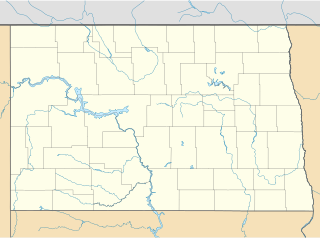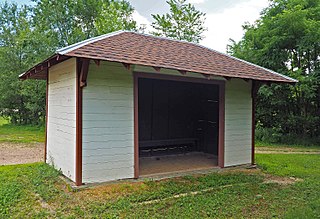
The Stone Arch Bridge is a former railroad bridge crossing the Mississippi River at Saint Anthony Falls in downtown Minneapolis, Minnesota. It is the only arched bridge made of stone on the entire length of the Mississippi River. It is the second oldest next to Eads Bridge. The bridge was built to connect the railway system to the new Union Depot, which at that time was planned to be built between Hennepin Avenue and Nicollet Avenue. The bridge was completed in 1883, costing $650,000 at the time. 117 Portland Avenue is the general address of the historic complex.

Saint Paul's Union Depot is a historic railroad station and intermodal transit hub in the Lowertown neighborhood of the city of Saint Paul, Minnesota, United States. It serves light rail, intercity rail, intercity bus, and local bus services.

The Basilica of Saint Mary is a Roman Catholic minor basilica located on its own city block along Hennepin Avenue between 16th & 17th Streets in downtown Minneapolis, Minnesota. It was the first basilica established in the United States. The Basilica of Saint Mary is the co-cathedral of the Roman Catholic Archdiocese of Saint Paul and Minneapolis.

Midway is a former Amtrak intercity train station in the Midway neighborhood of Saint Paul, Minnesota, United States. It was last served by Amtrak's daily Empire Builder and, for a time, by the North Star, as well as briefly by the North Coast Hiawatha.

Bandana Square, formerly the Como Shops of the Northern Pacific Railway, is now an office center, but it was originally designed to be an enclosed shopping center in the Energy Park neighborhood of Saint Paul, Minnesota. The site is in the National Register of Historic Places.

The Minneapolis Armory is an 8,400-person capacity music and events venue located in downtown Minneapolis, Minnesota, United States. The Armory was built for the Minnesota National Guard in 1935–36 and also used by the Minneapolis Lakers of the NBA from 1947-1960. It was listed on the National Register of Historic Places in 1985.

Winona is a historic train station in Winona, Minnesota, United States. It is served by Amtrak's daily Empire Builder service. It was originally built in 1888 by the Chicago, Milwaukee, St. Paul and Pacific Railroad, known later as the Milwaukee Road. A former Milwaukee Road freight house also exists here.

Red Wing is a train station in Red Wing, Minnesota, United States, served by Amtrak's Empire Builder, which runs daily between Chicago, Illinois and Seattle, Washington or Portland, Oregon. The next westbound stop is in Saint Paul, Minnesota and the next eastbound stop is in Winona, Minnesota.

St. Cloud is an Amtrak intercity train station in St. Cloud, Minnesota, United States, on Amtrak's daily Empire Builder service between Chicago, Illinois and Seattle, Washington or Portland, Oregon. The next westbound passenger stop is in Staples, Minnesota, and the next eastbound stop is in Saint Paul, Minnesota.)

Downtown Grand Forks is the original commercial center of Grand Forks, North Dakota. Located on the western bank of the Red River of the North, the downtown neighborhood is situated near the fork of the Red River and the Red Lake River. While downtown is no longer the dominant commercial area of the Greater Grand Forks community, it remains the historic center of Grand Forks. An 80.4-acre (32.5 ha) portion was listed on the National Register of Historic Places in 2005, as Downtown Grand Forks Historic District. Today, downtown Grand Forks is home to many offices, stores, restaurants, and bars.

Our Lady of Lourdes Catholic Church is a Roman Catholic parish church of the Archdiocese of Saint Paul and Minneapolis located in Minneapolis, Minnesota in the United States. It was built on the east bank of the Mississippi River in today's Nicollet Island/East Bank neighborhood; it is the oldest continuously used church building in the city and is part of the St. Anthony Falls Historic District.

The Minneapolis Great Northern Depot, also known as Great Northern Station, was a passenger railroad station which served Minneapolis, Minnesota, USA. It was built in 1913 and demolished in 1978. It was located on Hennepin Avenue next to the Hennepin Avenue Bridge and across the street from the main Minneapolis Post Office.

The Saint Paul Municipal Grain Terminal, also known as the head house and sack house, sits on piers over the Mississippi River in Saint Paul, Minnesota, United States. It was built between 1927 and 1931 as part of the Equity Cooperative Exchange and is a remnant of Saint Paul's early history as a Mississippi River port city. The Saint Paul Municipal Grain Terminal was added to the National Register of Historic Places in 2004.

The Minneapolis Saint Paul Rochester & Dubuque Electric Traction Company Depot or Orchard Gardens Railway Station, located at County Road 5 and 155th Street in Burnsville in the U.S. state of Minnesota was built in 1910 on the Dan Patch Line, later known as the Minneapolis, Northfield and Southern Railway. Connecting Northfield and Minneapolis, the line carried agricultural produce from rural Dakota County to urban markets. When Orchard Gardens in Burnsville was platted in 1910, this small depot was added for the area's passengers. Orchard Gardens farmers grew onions, apples, and flowers, and produced eggs and milk until the Great Slump caused locals to find employment in Minneapolis. Then the station attracted more commuters than farmers.

The Church of Saint Agnes is an onion-domed church building designed by George Ries, built 1901–1912 for the German-speaking Austro-Hungarian population of immigrants in Saint Paul, Minnesota, United States. It is listed on the National Register of Historic Places.

The Historic Triune Masonic Temple is a meetinghouse of Freemasonry in Saint Paul, Minnesota, United States, built in 1910 in the Neo-Classical Revival style, designed by Henry C. Struchen (1871–1947). The structure was built for Triune Lodge No. 190, AF & AM. It is one of the earliest and best preserved buildings erected exclusively for the use of a single Masonic Lodge. Henry Struchen, although not an architect, was a contractor and designer. He was a member of Triune Lodge and a prominent builder in the city.

The Church of St. Wenceslaus is a Catholic church in New Prague, Minnesota, United States, constructed in 1907. The church is flanked by a 1908 rectory and a 1914 parochial school, and the three-building complex is listed on the National Register of Historic Places for its association with the Czech American settlement of south-central Minnesota.

The Early Shakopee Houses are a pair of houses located at 411 and 419 East 2nd Avenue, Shakopee, Minnesota, United States. They are listed on the National Register of Historic Places.

Thief River Falls station is a historic train station in Thief River Falls, Minnesota. The station was built in 1913 to replace an earlier station and saw passenger traffic until 1967. It was listed on the National Register of Historic Places in 1995 as the Minneapolis, St. Paul and Sault Ste. Marie Railroad Depot and now serves as the Thief River Falls city hall.
The Montana Central Railway was a railway company which operated in the American state of Montana from 1886 to 1907. It was constructed by James Jerome Hill's St. Paul, Minneapolis & Manitoba Railway, and became part of the Great Northern Railway in 1889.

























